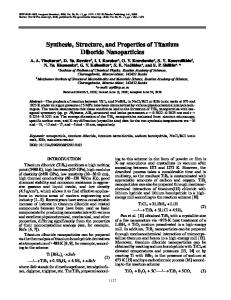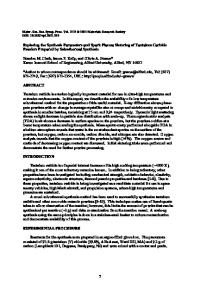Synthesis, Structure, and Superconducting Properties of Tantalum Carbide Nanorods and Nanoparticles
- PDF / 327,711 Bytes
- 7 Pages / 612 x 792 pts (letter) Page_size
- 83 Downloads / 317 Views
MATERIALS RESEARCH
Welcome
Comments
Help
Synthesis, structure, and superconducting properties of tantalum carbide nanorods and nanoparticles Akihiko Fukunaga, Shaoyan Chu, and Michael E. McHenry Department of Materials Science and Engineering, Carnegie Mellon University, Pittsburgh, Pennsylvania 15213-3890 (Received 10 July 1997; accepted 5 December 1997)
Tantalum carbide nanorods and nanoparticles have been synthesized using a vapor-solid reaction path starting with CVD grown carbon nanotube precursors. Their structures were studied using XRD, TEM, and HRSEM. Superconducting properties were characterized using a SQUID magnetometer. For reactions at lower temperatures, carbide nanorods, which replicate the ,14 nm diameter of the precursor carbon nanotubes, are observed. For higher temperature reactions, coarsened carbide nanoparticles (100–250 nm) are observed which have spherical or cubic-faceted morphologies. A morphological Rayleigh instability is postulated as initiating the transition from nanorod to nanoparticle morphologies. Stoichiometric bulk TaC crystallizes in the rock salt structure and has a superconducting transition temperature of 9.7 K. In TaC nanorods and nanoparticles, the superconducting properties correlate with the lattice parameter. Nanoparticles with a little higher lattice parameter than the ideal one show higher Tc and higher fields at which the superconductivity disappears than stoichiometric bulk TaC.
I. INTRODUCTION 1–5
Carbon nanotubes, cylindrical graphitic carbon sheets, constitute new and promising materials which have evolved from the discovery of fullerenes and related materials. These materials may have significant potential in advanced electrical and mechanical applications. For instance, the modification of carbon nanotubes by filling with a metal species opens up several possibilities for potential uses because the properties of modified fibers could be very different from the original carbon material. Encapsulation6,7 might have interesting effects on the properties (such as superconductivity or magnetism) of the interior phase. Carbon nanotubes produced by a metal-catalyzed route consist of few graphitic multilayers and therefore may easily react with transition metals and yield interesting transition metal carbides.8–11 In a recent study12 it was reported that TiC, SiC, and NbC nanorods could be obtained in the vapor-solid reactions and that NbC nanorods exhibited superconductivity. In this work we report on the synthesis of TaC nanorods and nanoparticles. We describe interesting observations of superconducting properties and then concentrate our discussion on explanations for the observed particle morphologies. Our distinction between nanorods and nanoparticles is a morphological one. This is explained in terms of a Rayleigh instability13 in rod morphologies which give rise to perturbations of wavelength, l, which eventually can lead to break up of the rods into nanocrystallites. If l is less than 2pR0 (R0 : initial unperturbed rod radius) for a perturbed rod with is
Data Loading...










